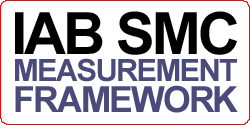10 March 2011
Sheen saga shows how social should be
Mairi Clark, senior PR and marketing manager, IAB
The Charlie Sheen saga has been both captivating and depressing at the same time. While it’s like watching a car crash, I am not the only person who has performed out of character by subscribing to his Twitter feed and hungrily absorbing every nugget of strange mutterings.
Let’s put the ethics of watching a human being having a breakdown to one side, as we approach the fifth birthday of Twitter, it’s fascinating that after treading the Hollywood line of having a publicist for his entire career, Sheen has gone down the road of doing his ‘media’ himself.
The impact for the social media industry will be interesting to watch. Until now, not very many people realised there was this growth area of promotional social media, where celebrities are paid vast amounts of money to promote products.
His rise of popularity on Twitter has been of benefit to many companies and even charities, which have made use of his #tigerblood hashtag.
It’s that kickback that’s interesting. In a month of Twitter errors – Red Cross staff drinking, Chrysler complaining about drivers – the way brands are reacting to errant Tweets says a lot about the companies’ social media drivers. While Red Cross have been excellent, Chrysler took the corporate line. Red Cross used its Twitter faux pas to great advantage. After Tweeting a witty response, it was then endorsed by DogFish – the brand the staff drank and then Tweeted about – whose fanbase reacted by Tweeting people to donate blood, and the whole thing became a unexpected marketing hit.
What marketers need to remember about social media is that by its very definition, it’s about people. And the problem with people is that you can’t control them. So the first thing you should do is loosen the control.
And only then, are you #winning.
by Eva Keogan, Head of Social, LBi ,
News broke yesterday that Facebook is courting the creative leads of UK digital agencies including LBi and has invited them to attend its first ‘Influencer Summit’ at its Palo Alto HQ in California. This marks an exciting shift in the stakeholder landscape as media agencies have been first at the table of the Facebook monetisation feast.
The event is essentially a brainstorm to evolve the next wave of social advertising and the shape it will take. Chris Clarke, our Chief Creative Officer, is one of the lucky ones who will attend the Facebook Summit.

‘It was an impressive invite and I’m easily tempted by fine wine.’ said Chris. ‘I’ve also got huge respect for Facebook and am intrigued to see first hand what they’re up to. As a business it’s obviously a formidable force, but as a brand it suffers from a bit of an image problem. Is this the beginning of them addressing that?’ he continued.
With the recent funding announcement and an IPO in the mix, needs to demonstrate that it has the depth and breadth of revenue streams to outlast less fortunate digital spaces which have experienced the boom and bust phenomenon; think Second Life and MySpace, if you will.
So while many of us who are running communities and getting good revenue streams from this social network may be thinking ‘How long before Facebook starts charging us for this ‘free to air’ platform?’ the Influencer Summit promises an exciting agenda and endless possibilities.
At LBi, we are increasingly aware that Facebook is fast becoming the de facto lead social network in most countries around the world. Russia, China, India and Brazil all have domestic networks which are putting up a good fight in the face of this global phenomenon but in countries like Germany and Spain, home grown social networks are shrinking in its wake.
What this means is that when global clients are making a decision about which social network to choose, Facebook is increasingly becoming the first choice. The world leading brands stay on top due to constant innovation, reinvention and pushing boundaries, so it makes sense that Facebook would aspire to do the same to court such a lucrative audience and what better way to do it than to crowdsource from the cream of the crop in the creative industry?
by Rob Salmon, Director of Digital Marketing at Torchbox
In a very little while I’d like to look at Facebook’s new communications system which was announced on Monday 15 November, its key features and what it could mean for organisations using Facebook. If you’ve not read up on this I’d suggest taking a view of this video to start of with.
First up though, three quick ways I’ve used Facebook to communicate in the past week.
Last Saturday, I tried to fix our dishwasher. I am not like Bob The Builder. He can fix things. I didn’t even have the right screwdriver. So I put an appeal out to my Facebook friends. Within minutes I had had a few sarcastic comments and a few offers of help. Read more…
By Dhiren Shingadia, Market Sentinel
Back in July I quickly punched together a blog post about earned media planning. My thoughts were originally inspired by Daniel Goodall, from Nokia, and I wanted to put together some sort of framework which outlined the key areas, or considerations, that a planner may need to take into account.
The nice chaps at MediaPro found my post quite interesting, so they asked me to expand on my thoughts at the MediaPro conference that recently passed. The entire event focused on the “the future of integrated communications” so there were some very useful seminars about content, moderation and community management.
I definitely recommend popping down next year.
My deck can be found below:
By Amy Kean, head of the IAB social media council, .
You may remember back in September, the ASA announced the formal extension of its remit to the non paid-for space… This, inevitably, will include many areas of social media activity – most notably pages on social networking and microblogging sites where many brands now have a presence.
In the IAB’s view this is a welcome development, further reinforcing the integrity of social media and promoting the ideology that all branded communications should be ‘legal, decent, honest and truthful’, as laid out within the CAP Code. After all, shouldn’t we all strive to achieve these things, and interact with consumers without intentionally misleading them? Our friends at We Are Social articulated this perfectly over here.
The commentary surrounding the initial announcement sparked a certain amount of debate about what exactly constitutes ’social media’ and the implications for the PR industry. We spoke to the ASA’s CEO, Guy Parker, to ask some questions on behalf of the IAB membership and obtain further clarification on the perceived ‘grey area’ between social media and public relations. Enjoy!
by , Torchbox ()
The first ‘Facebook for Good’ conference was held yesterday in London, bringing together charities for a wide range of presentations and discussions about how to use Facebook to its fullest potential.
The event was kick started by a keynote speech from Randi Zuckerberg, Head of Consumer Marketing at Facebook.
What I liked about Randi’s speech was that she gave 10 tips that she believes will deliver winning Facebook pages. For some readers, it may seem like relatively common sense style info. However, that doesn’t mean to say everyone is practising what Randi preached so I thought I’d share the tips (they appear within the speech marks) along with my feelings on each as they’re relevant to all organisations not just the charitable sector. Seconds out tip one:
1. ‘Create a public page not a group.’ This is because there are lots of benefits with pages – for example you can get a personalised url, you get option of multiple logins, the posts come from the title of your page rather than an individual, you get access to the Insights data.
2. ‘Customize your Facebook page’ make it represent what your brand is all about. I think this is an interesting one as I reckon some people like entering on the wall and seeing what the page is all about before deciding whether to like. However, there is no reason why tabs can’t be used to deliver content that reflects a brand’s personality. I liked the example given by of iPlatform later in the day (who also runs the ) of the FA’s Support England tab which allowed you to put your name on the back of a virtual England shirt in run up to the World Cup. England may have faIled at the World Cup – but that was a winning campaign.
3. ‘Come up with rules of engagement’ – I guess this covers a wide range of stuff from deciding and stating what’s allowed and what isn’t, to figuring out the best time to post, to whether you’ll be using photos / vIdeo. In short, have a plan. It was interesting to hear that M&S have a meeting to discuss this week’s and next week’s wall updates. Like an editorial team in a newspaper.
4. ‘Encourage community interaction’ – if you can you might just turn from a page that people like to one that people love! I love the way Cobra uses Facebook to lead . Just the thought makes me yearn for a madras, garlic naan and bottle of Cobra – but enough of that. Tip five awaits…
5. ‘Be authentic’- my take on this is don’t try and be something you’re not. Use a tone of voice and imagery that befits the organisations you’re representing. And be polite and don’t say something you wouldn’t say in a public space.
6. ‘Get immediate feedback’ – if you have a community who are engaged, they’re defo going to want to be involved. So if you have a question you’d like feedback on, the community can be a great resource to make that happen.
7. ‘Leverage the power of video’ – I’m with Randi on this one. A little while ago I started up a for fun in my spare time and the most successful feature has been Ask A Silly Question, video interviews with community members asking stuff like ‘if you could be a comic book hero for the day who would you be and why?’ recorded and uploaded from an iPhone. Around 80% of the people that like the page watched the first video!
8. ‘Get creative!’ – effective creativity will result in compelling content that spreads. And if you’re an early adopter, the content can drive a news agenda. The one I’m pondering right now is how to use Facebook Places. Seems other folk are too, take James Blunt’s record label and how they’ve used Facebook Places to reward check ins with free downloads.
9. ‘Make it go viral!’ – tagging can help a post go viral and there’s been few better uses of tagging than ‘the most tagged photo ever at Glastonbury‘ which was highlighted. My view is that it is a combination of compelling content and effective amplification (i.e creativity and hard graft) that results in something going viral.
10. ‘Use insights to guide decisions’ – hear hear Randi. Not everyone uses the free Insights data that Facebook makes available but everybody should because the lessons you learn can help improve the way your campaigns perform. And that’s got to be a good thing…
So there you have it, Randi’s top ten tips! If you’d like to keep in touch about future Facebook for Good events, my tiny tip is head over to the page. If you want more info on best practice with your Facebook page there’s load of info here: .
By head of the social media council, IAB
You may have noticed, but here at the IAB we get excited about a lot of things.
But nothing gets us hot under the digital collar like the biannual IAB UK online adspend results, which hit the headlines today. Every six months, in partnership with PwC, we measure the size of the UK market to help marketers understand the true scale of the medium and to provide the digital industry with the ammunition it needs to make the case for even bigger budgets.
And what IS the headline? Well, we hit a really-quite-perfect 10% in terms of year-on-year growth, with every format within online (search, display and classifieds) seeing an increase in advertising investment. The medium hit almost £2 billion in just six months, with an impressive 24.3% market share. Good news all round.
You can read the official story on the IAB site, but what readers of this blog might be interested in is where ‘social’ fits within this online success story.
Just to be clear, the figures set out in the IAB/PwC study refer to advertising expenditure online, so no production or agency costs are included… this means that a lot of social spending – i.e. money spent on creative, budgets dedicated blogger outreach programmes, social media monitoring costs and so on – doesn’t feature amongst the results. That figure, I would imagine, is pretty damn big on its own.
But what we can measure in this study is the advertising that lives on social networks, blogs, forums, online communities and so on, and this is now a whopping 13% of all online display (all online display was worth £334.6 million in H1 2010, so you do the math!) Last year we estimated social to account for around 10% of all online display, and if you cast your minds back just a few years ago… well, it was barely on the adspend radar. Read more…
by , Torchbox
New services, new sites, new social channels, new this, that and the other. A typical day in the digital world. Once in a while though you hear about something new that you think might be a game changer. I think ‘Live On YouTube’ fits that bill…
But if you want to see what I’m talking about you better be quick for ‘Live On YouTube’ is a two day trial and that trial finishes today (the 14th September). To see what programs are on and read more about YouTube’s intentions, just visit this YouTube blog post. If you’re reading this blog after 14th September, I’m sorry…
So why do I think this move from YouTube is a potential game changer?
Services like uStream and Justin.tv have shown that the power to broadcast live now lies in the hands of anyone who has a laptop, video camera and internet connection.
This was neatly summed up in March 2010 when writing about the US Embassy’s decision to broadcast a press conference live on Justin.tv, the site’s blogger said: ‘We’re excited to have the Vice President on Justin.tv. And we’re even more excited that this isn’t a big, elaborate production that most users would have no chance of replicating. The folks running the broadcast are plugging a camera into a laptop and going. That’s the way we think live video can be really powerful for everyone to use, and that includes the Vice President.’??And the US Embassy is not alone.
More and more organisations – from Glastonbury’s Emerging Talents Competition to Greenpeace’s demonstrations – are now taking advantage of the ability to broadcast live – and then using the footage as video content that can be fed into an archive.
However, whilst uStream and Justin.tv are hugely popular sites that are well worth checking out, they are nowhere near as big as YouTube. If YouTube puts live broadcasting into the hands of their partners (note: YouTube are saying ‘partners’ in their material and not everyone – see ), it has the potential for live broadcasting to go mainstream in the same way that Facebook Places may take location services pioneered by the likes of Foursquare into the mainstream.
The most exciting thing about this for me will be when more and more have online TV. If I work for a brand, charity, band, sports team etc etc, and they are a YouTube partner, they will have the potential to broadcast live onto someone’s TV (or laptop, mobile, iPad etc) and drive a social stream alongside it. If you can let your audience know about it through email, social media channels etc, you could be competing with the mainstream broadcasters at a fraction of the cost.
I’ve thought for a while that live broadcasting is one to watch and one to trial. This conviction is certainly strengthened by YouTube’s decision to run the test. I hope you read this story whilst you still had a chance to see it live…
, Group Planning Director at TMW
Before a brand commits to any social media campaign, activity or platform it’s clearly essential to understand how their target audience behaves in these environments. For example, which environments does your target audience frequent? How active are they in this space? Are they the types of people who proactively share and contribute to the conversation or do they prefer to observe by the sidelines? Are they likely to invest time and energy in UGC or would such an invitation fall on deaf ears? What are the motivations and key drivers that lie behind their social media behaviour?
Unless one can answer these types of questions, there’s a fair chance your social media efforts could all be in vein. The good news, however, is that there are a number of sources, tools and frameworks available which can help us build a fairly informed picture of our target audience’s social media profile. And the best bit, most of them are completely free! Outlined below are the ones I’m most familiar with or have found to be most useful over the years. I’ve also restricted the list to those tools which can be applied across European markets and not just the US.
1. The Global Web Index
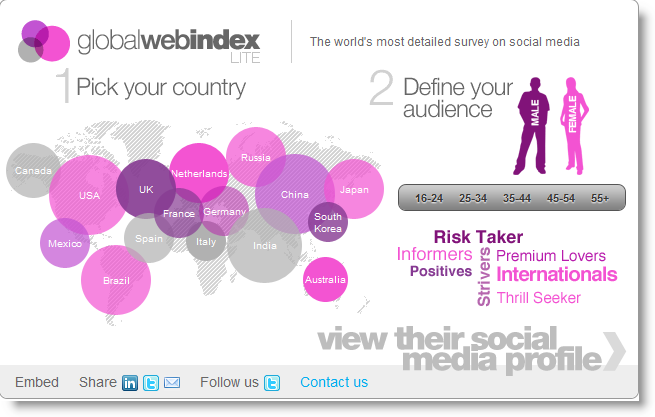
The Global Web Index (Lite) is a nifty little free tool recently published by Trendstream to help you view the social media profiles of different online audiences across Europe. It’s based on a quantitatitive survey and manages to overlay social media behaviour and motivations by country, age and attitudinal profiles. The full version will have a lot more meat on the bones but for a quick snapshot this Lite version can be quite an insightful tool, particularly when comparing against different markets.
2. Universal McCanns Social Media Tracker
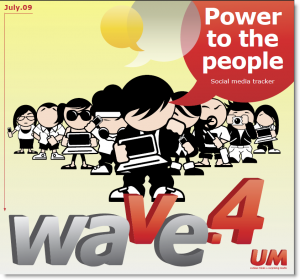
This in my view is the holy grail when it comes to tracking trends in social media from a global perspective. It’s been going a few years now and is an essential point of reference for anyone trying to identify behavioural trends in social media. There’s a free Silverlight-based tool here which is quite fancy but for usable insights and stats you really need to read the Wave 4 report . Pure gold dust!
3. Forresters Social Technographics Tool
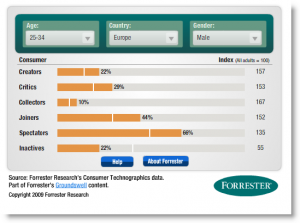
Forrester’s social technographics tool has been around for a while but is still a great way to map your target audience’s propensity to participate in social media. With this tool you can get a decent idea whether your audience over indexes for certain types of behaviour. So for example, if they over index as ‘creators’ there’s a fair chance they’d be receptive to getting involved in a crowdsourcing or UGC project. Conversely, if they’re predominently spectators and inactives, don’t even go there!
Unfortunately some European markets are not covered for some age profiles which I assume is because they don’t hold enough survey data but for broad, topline assessment of socialgraphics it’s a great place to start.
4. Altimeter’s Engagement Pyramid
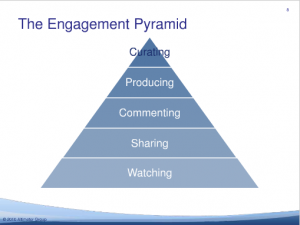
This isn’t a data analytical tool as far as I believe but rather a strategic framework to help map the different ways in which consumers engage in social media. Even though there’s no data to substantiate this, it’s good common sense and highlights the importance of socialgraphics to help inform social media strategies rather than simply relying on traditional demographic and psychographic profiles. If you want to know more about this interesting approach I’ve reviewed it more fully on my blog.
5. TMW’s Motivational Drivers to Social Media Participation
Understanding ‘how’ your target audience participates in social media is key but only one piece of the jigsaw. It’s also important to ask yourself ‘why’. At TMW, we conducted some research in conjunction with research agency ICM to help identify the motivations behind social media participation. We concluded there are 6 key motivational drivers for participating in this space.
* Discovery: for self-development or to learn from others
* Altruism: to help others make the right decision or become involved in the brand’s product decision
* Social: to connect to the like minded, reinforce tribal identity or gain a sense of belonging
* Fame: for personal notoriety or to challenge their ability against others
* Escapism: for entertainment and an escape from the daily routine
* Expression: as an outlet for their imagination or expression of personal identity
The interesting thing is that these motivations change according to different demographics. You can read some of the insightful results from this study on my blog here where we explore the differences in motivations between gender and age.
6. TGI Net Europa
Launched in September 2008, with new data released twice a year, TGI Net Europa combines the full TGI Europa database with extensive detailed information on internet behaviour and attitudes. To be fair it’s probably more useful to draw broader conclusions on internet behaviour for a given target audience than building robust socialgraphic data. It’s not a free tool either so if you want access this type of data you may have to ask your media agency nicely!
7. Social Media Statistics Compendium by econsultancy
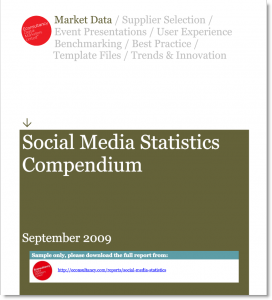 The Social Media Statistics Compendium is one of the reports bundled with the eConsulancy’s Internet Statistics Compendium. It costs £250 on its own but is jam packed with useful stats on social media from a variety of third party sources.
The Social Media Statistics Compendium is one of the reports bundled with the eConsulancy’s Internet Statistics Compendium. It costs £250 on its own but is jam packed with useful stats on social media from a variety of third party sources.
8. CheckFacebook.com

If you want to understand the profile of Facebook users within your country and compare this to your target audience profile, it’s worth visiting . It’s free too.
9. Nielson’s Global Faces & Networked Places Report – March 2009
Nielson’s Global Faces and Network Places report looks at the social media market as a whole but does have a useful section on how the audience is changing and starting to mature.
10 IAB Online Audience Research
Last but not least, there are a number of helpful online research papers available to IAB members including some for specific audiences such as women, Mums and luxury consumers)
Summary
So there you have it – a mix of tools and approaches to help you build up a social media profile of your target audience. It’s not an exhaustive list by any stretch of the imagination so if you know any more I may have missed feel free to add them below.
For the last twenty-four months, or so, storytelling has become more important to Account Planners and Brand Strategists alike. Stories are memorable; stories get shared; stories deliver meaning and answer the innate why and how questions: How did you come to be? Why are you talking to me? Why should I buy your product?
Our analysis team has been working to understand product anecdotes for some of our clients recently. This has involved reading some of the everyday product stories that are embedded within social media.
Their findings have been fascinating and they have stimulated conversations that question the direction of the brand, its segmentation preferences and marketing activities. The key takeaway for us: Before you start to tell your story, read the stories that have already been written about your brand and understand their contexts and implications.
Understanding what’s already out there will better place us, brand people, to define our own stories, make them culturally relevant and ensure they effectively answer the aforementioned, innate questions.
Dhiren Shingdia – Market Sentinel





 The
The 

